Influence of the Processing Method on the Nano-Mechanical Properties and Porosity of Dental Acrylic Resins Fabricated by Heat-Curing, 3D Printing and Milling Techniques
Abstract
1. Introduction
2. Aim
3. Materials and Methods
3.1. Experimental Samples
3.1.1. Traditional Method
3.1.2. Subtractive Method (Milling)
3.1.3. Additive Method (3D Printing)
3.2. Indentation Tests
3.3. Micro-CT Analysis
3.4. Statistical Analysis
4. Results
4.1. Results of Nanomechanical Investigations
4.2. Porosity Evaluation by Micro-CT
5. Discussion
6. Conclusions
Author Contributions
Funding
Institutional Review Board Statement
Informed Consent Statement
Data Availability Statement
Acknowledgments
Conflicts of Interest
References
- Valenti, C.; Federici, M.I.; Coniglio, M.; Betti, P.; Pancrazi, G.P.; Tulli, O.; Masciotti, F.; Nanussi, A.; Pagano, S. Mechanical and biological properties of polymer materials for oral appliances produced with additive 3D printing and subtractive CAD-CAM techniques compared to conventional methods: A systematic review and meta-analysis. Clin. Oral Investig. 2024, 28, 396. [Google Scholar] [CrossRef] [PubMed]
- Ribeiro, A.K.C.; de Freitas, R.F.C.P.; de Carvalho, I.H.G.; de Miranda, L.M.; da Silva, N.R.; de Fátima Dantas de Almeida, L.; Zhang, Y.; da Fonte Porto Carreiro, A.; de Assunção, E.; Souza, R.O. Flexural strength, surface roughness, micro-CT analysis, and microbiological adhesion of a 3D-printed temporary crown material. Clinical oral investigations 2023, 27, 2207–2220. [Google Scholar] [CrossRef] [PubMed]
- Khosravani, M.R. Mechanical behavior of restorative dental composites under various loading conditions. J. Mech. Behav. Biomed. Mater. 2019, 93, 151–157. [Google Scholar] [CrossRef] [PubMed]
- Gomes de Carvalho, A.B.; de Andrade, G.S.; Mendes Tribst, J.P.; Grassi, E.D.A.; Ausiello, P.; Saavedra, G.; Bressane, A.; Marques de Melo, R.; Borges, A.L.S. Mechanical Behavior of Different Restorative Materials and Onlay Preparation Designs in Endodontically Treated Molars. Materials 2021, 14, 1923. [Google Scholar] [CrossRef] [PubMed]
- Zabrovsky, A.; Beyth, N.; Pietrokovski, Y.; Ben-Gal, G.; Houri-Haddad, Y. 5—Biocompatibility and functionality of dental restorative materials. In Biocompatibility of Dental Biomaterials; Shelton, R., Ed.; Woodhead Publishing: Cambridge, UK, 2017; pp. 63–75. [Google Scholar]
- Hatton, P.V.; Mulligan, S.; Martin, N. The safety and biocompatibility of direct aesthetic restorative materials. Br. Dent. J. 2022, 232, 611–614. [Google Scholar] [CrossRef]
- Pantea, M.; Ighigeanu, D.A.; Totan, A.; Greabu, M.; Miricescu, D.; Imre, M.M.; Totan, C.; Spinu, T.C.; Petre, A.; Bencze, A.; et al. Interactions Between Dental Composite Resins and Saliva A comparative biochemical in vitro study. Mater. Plast. 2019, 56, 529–533. [Google Scholar] [CrossRef]
- Vichi, A.; Margvelashvili, M.; Goracci, C.; Papacchini, F.; Ferrari, M. Bonding and sealing ability of a new self-adhering flowable composite resin in class I restorations. Clin. Oral Investig. 2013, 17, 1497–1506. [Google Scholar] [CrossRef]
- O’Connor, C.; Gavriil, D. Predictable bonding of adhesive indirect restorations: Factors for success. Br. Dent. J. 2021, 231, 287–293. [Google Scholar] [CrossRef]
- Bayne, S.; Petersen, P.; Piper, D.; Schmalz, G.; Meyer, D. The Challenge for Innovation in Direct Restorative Materials. Adv. Dent. Res. 2013, 25, 8–17. [Google Scholar] [CrossRef]
- Hegde, M.N.; Hegde, P.; Bhandary, S.; Deepika, K. An evaluation of compressive strength of newer nanocomposite: An in vitro study. J. Conserv. Dent. 2011, 14, 36–39. [Google Scholar] [PubMed]
- Alshamrani, A.; Alhotan, A.; Kelly, E.; Ellakwa, A. Mechanical and Biocompatibility Properties of 3D-Printed Dental Resin Reinforced with Glass Silica and Zirconia Nanoparticles: In Vitro Study. Polymers 2023, 15, 2523. [Google Scholar] [CrossRef] [PubMed]
- Dimitrova, M.; Vlahova, A.; Hristov, I.; Kazakova, R.; Chuchulska, B.; Kazakov, S.; Forte, M.; Granberg, V.; Barile, G.; Capodiferro, S.; et al. Evaluation of Water Sorption and Solubility of 3D-Printed, CAD/CAM Milled, and PMMA Denture Base Materials Subjected to Artificial Aging. J. Compos. Sci. 2023, 7, 339. [Google Scholar] [CrossRef]
- Yang, D.-L.; Sun, Q.; Niu, H.; Wang, R.-L.; Wang, D.; Wang, J.-X. The properties of dental resin composites reinforced with silica colloidal nanoparticle clusters: Effects of heat treatment and filler composition. Compos. Part B Eng. 2020, 186, 107791. [Google Scholar] [CrossRef]
- Hata, K.; Ikeda, H.; Nagamatsu, Y.; Masaki, C.; Hosokawa, R.; Shimizu, H. Dental Poly(methyl methacrylate)-Based Resin Containing a Nanoporous Silica Filler. J. Funct. Biomater. 2022, 13, 32. [Google Scholar] [CrossRef] [PubMed]
- Henriks-Eckerman, M.-L.; Suuronen, K.; Jolanki, R.; Alanko, K. Methacrylates in dental restorative materials. Contact Dermat. 2004, 50, 233–237. [Google Scholar] [CrossRef] [PubMed]
- Curtis, A.R.; Palin, W.M.; Fleming, G.J.; Shortall, A.C.; Marquis, P.M. The mechanical properties of nanofilled resin-based composites: Characterizing discrete filler particles and agglomerates using a micromanipulation technique. Dent. Mater. 2009, 25, 180–187. [Google Scholar] [CrossRef]
- Salary, S.; Dadkan, S.; Khakbiz, M.; Atai, M. Effect of nanoparticles on surface characteristics of dental nanocomposite. Med. Devices Sens. 2020, 3, e10081. [Google Scholar] [CrossRef]
- Tamimi, F.; Hirayama, H. Digital Restorative Dentistry: A Guide to Materials, Equipment and Clinical Procedures; Springer International Publishing: Cham, Switzerland, 2020; p. 201. [Google Scholar]
- Jain, P.; Gupta, M. Digitalization in Dentistry: Clinical Applications; Springer International Publishing: Cham, Switzerland, 2021. [Google Scholar]
- Abdulkarim, L.I.; Alharamlah, F.S.S.; Abubshait, R.M.; Alotaibi, D.A.; Abouonq, A.O. Impact of Digital Workflow Integration on Fixed Prosthodontics: A Review of Advances and Clinical Outcomes. Cureus 2024, 16, e72286. [Google Scholar] [CrossRef]
- Borse, P.; Jain, S.; Bhasin, N.; Grover, R.K.; Singh, B.; Longkumer, P. Comparison of Dimensional Accuracy and Stability of 3D-Printed, Computer-Aided Design/Computer-Aided Manufacturing (CAD/CAM), and Conventional Polymethyl Methacrylate (PMMA) Denture Base Materials: An In Vitro Study. Cureus 2025, 17, e85128. [Google Scholar] [CrossRef]
- As, O. Modern Innovations in Digital Dentistry: A Review of CAD/CAM Restorations. Int. J. Dent. 2024, 11, 56–70. Available online: https://www.researchgate.net/publication/386268972_Modern_Innovations_in_Digital_Dentistry_A_Review_of_CADCAM_Restorations (accessed on 4 February 2025).
- Patel, D.K.; Sakhaei, A.H.; Layani, M.; Zhang, B.; Ge, Q.; Magdassi, S. Highly stretchable and UV curable elastomers for digital light processing based 3D printing. Adv. Mater. 2017, 29, 1606000. [Google Scholar] [CrossRef] [PubMed]
- Revilla-León, M.; Özcan, M. Additive manufacturing technologies used for processing polymers: Current status and potential application in prosthetic dentistry. J. Prosthodont. 2019, 28, 146–158. [Google Scholar] [CrossRef] [PubMed]
- Gad, M.M.; Rahoma, A.; Abualsaud, R.; Al-Thobity, A.M.; Akhtar, S.; Siddiqui, I.A.; Al-Harbi, F.A. Influence of artificial aging and ZrO2 nanoparticle-reinforced repair resin on the denture repair strength. J Clin Exp Dent. 2020, 12, e354–e362. [Google Scholar] [CrossRef]
- Anusavice, K.J.; Shen, C.; Rawls, H.R. Phillips’ Science of Dental Materials, 12th ed.; Elsevier Health Sciences: St. Louis, MO, USA, 2012. [Google Scholar]
- ISO 20795-1:2013; Edition 2, 2013, reviewed and confirmed in 2021, Dentistry— Base polymers—Part 1: Denture base polymers. International Organization for Standardization: Geneva, Switzerland. Available online: https://www.iso.org/standard/62277.html (accessed on 10 February 2025).
- Ciocan, L.T.; Vasilescu, V.G.; Pantea, M.; Pițuru, S.M.; Imre, M.; Ripszky Totan, A.; Froimovici, F.O. The Evaluation of the Trueness of Dental Mastercasts Obtained through Different 3D Printing Technologies. J. Funct. Biomater. 2024, 15, 210. [Google Scholar] [CrossRef] [PubMed]
- Ciocan, L.T.; Biru, E.I.; Vasilescu, V.G.; Ghitman, J.; Stefan, A.-R.; Iovu, H.; Ilici, R. Influence of Air-Barrier and Curing Light Distance on Conversion and Micro-Hardness of Dental Polymeric Materials. Polymers 2022, 14, 5346. [Google Scholar] [CrossRef] [PubMed]
- Rus, F.; Neculau, C.; Imre, M.; Duica, F.; Popa, A.; Moisa, R.M.; Voicu-Balasea, B.; Radulescu, R.; Ripszky, A.; Ene, R.; et al. Polymeric Materials Used in 3DP in Dentistry—Biocompatibility Testing Challenges. Polymers 2024, 16, 3550. [Google Scholar] [CrossRef]
- Available online: https://www.spofadental.com/resource-center/superpont-cb (accessed on 24 February 2022).
- Available online: https://pritidenta.com/en/ifu/current-instruction-for-use/?lang=2&prod=19 (accessed on 24 February 2022).
- Prpic, V.; Spehar, F.; Stajdohar, D.; Bjelica, R.; Cimic, S.; Par, M. Mechanical properties of 3D-printed occlusal splint materials. Dent. J. 2023, 11, 199. [Google Scholar] [CrossRef]
- Available online: https://www.bego.com/fileadmin/user_downloads/Mediathek/3D-Druck/Materialien/EN_Sicherheitsdatenblatt/VarseoSmileTemp/VarseoSmile-Temp_41022_702621_GB_EN_V-3.0.0_SDB.pdf (accessed on 7 March 2022).
- Available online: https://dentamidshop.dreve.de/daten/enu_dentamid_tds_fotodent_splint_gb.pdf?expired=1731864874 (accessed on 10 December 2024).
- Chakraborty, H.; Sinha, A.; Mukherjee, N.; Ray, D.; Chattopadhyay, P.P. A study on nanoindentation and tribological behaviour of multifunctional ZnO/PMMA nanocomposite. Mater. Lett. 2013, 93, 137–140. [Google Scholar] [CrossRef]
- Karimzadeh, A.; Koloor, S.S.R.; Ayatollahi, M.R.; Bushroa, A.R.; Yahya, M.Y. Assessment of nano-indentation method in mechanical characterization of heterogeneous nanocomposite materials using experimental and computational approaches. Sci. Rep. 2019, 9, 15763. [Google Scholar] [CrossRef]
- Saramet, V. Nano-Mechanical Properties and Biochemical Interactions in the Oral Environment. Ph.D. thesis, “Carol Davila” University of Medicine and Pharmacy, Bucharest, Romania, 2024. Available online: https://umfcd.ro/wp-content/uploads/2024/SCOALA_DOCTORALA/TEZA_DOCTORAT/SARAMET_V_VEACESLAV/REZUMAT%20teza%20V.Saramet.pdf (accessed on 10 February 2025).
- Han, Q.; Qu, Z.; Ye, Z. Research on the mechanical behaviour of shale based on multiscale analysis. R. Soc. Open Sci. 2018, 5, 181039. [Google Scholar] [CrossRef]
- Chen, Y.; Sun, C.; Cao, J.; Wu, Y.; Cui, B.; Ma, J.; Wang, H. Mechanical properties and in vitro biocompatibility of hybrid polymer-HA/BAG ceramic dental materials. Polymers 2022, 14, 3774. [Google Scholar] [CrossRef] [PubMed]
- Tsoi, J.K.H. ‘New’ AI in Prosthodontics—What Has Changed Two Years On? Br. Dent. J. 2025, 238, 799–800. [Google Scholar] [CrossRef] [PubMed]
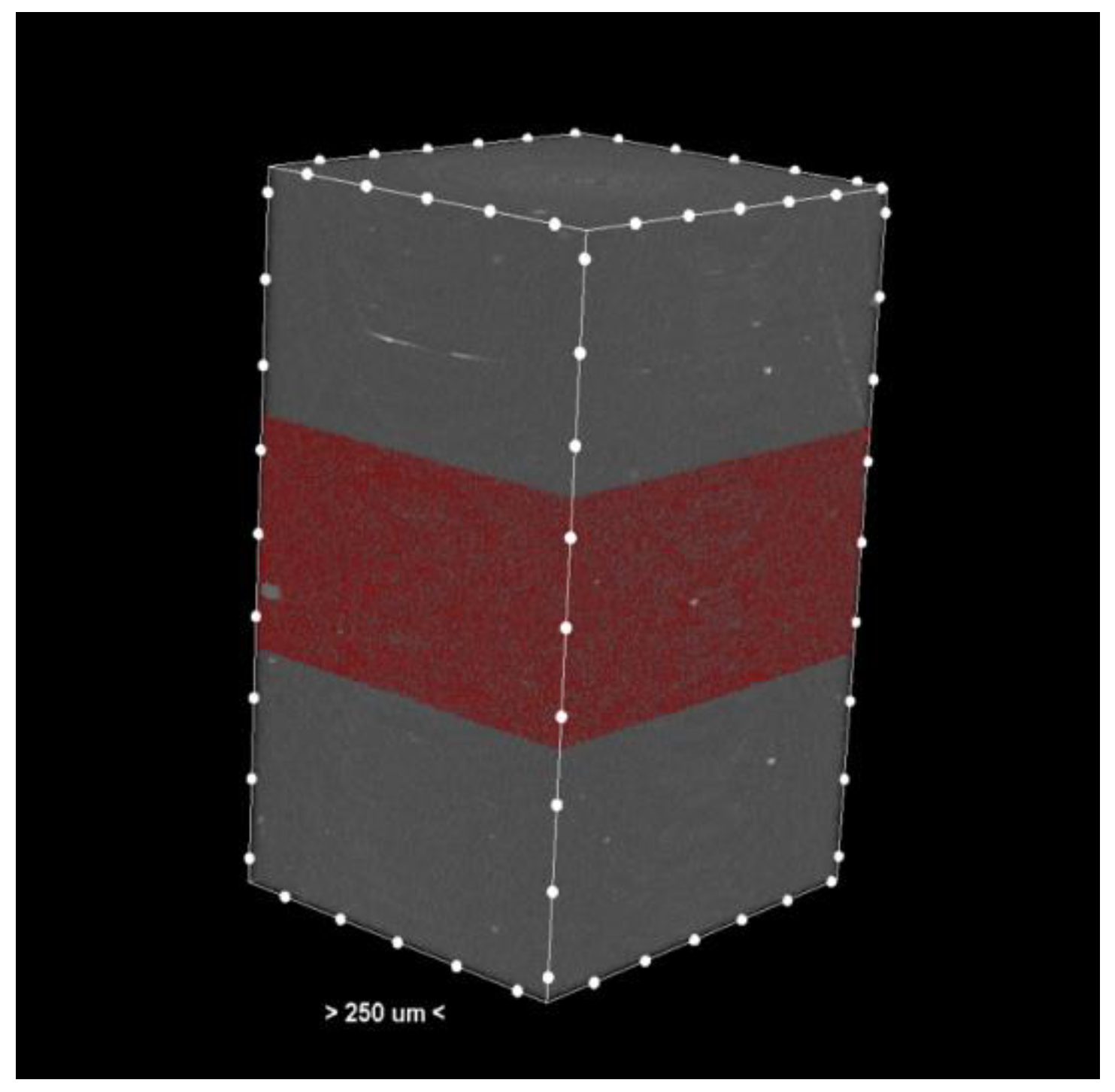
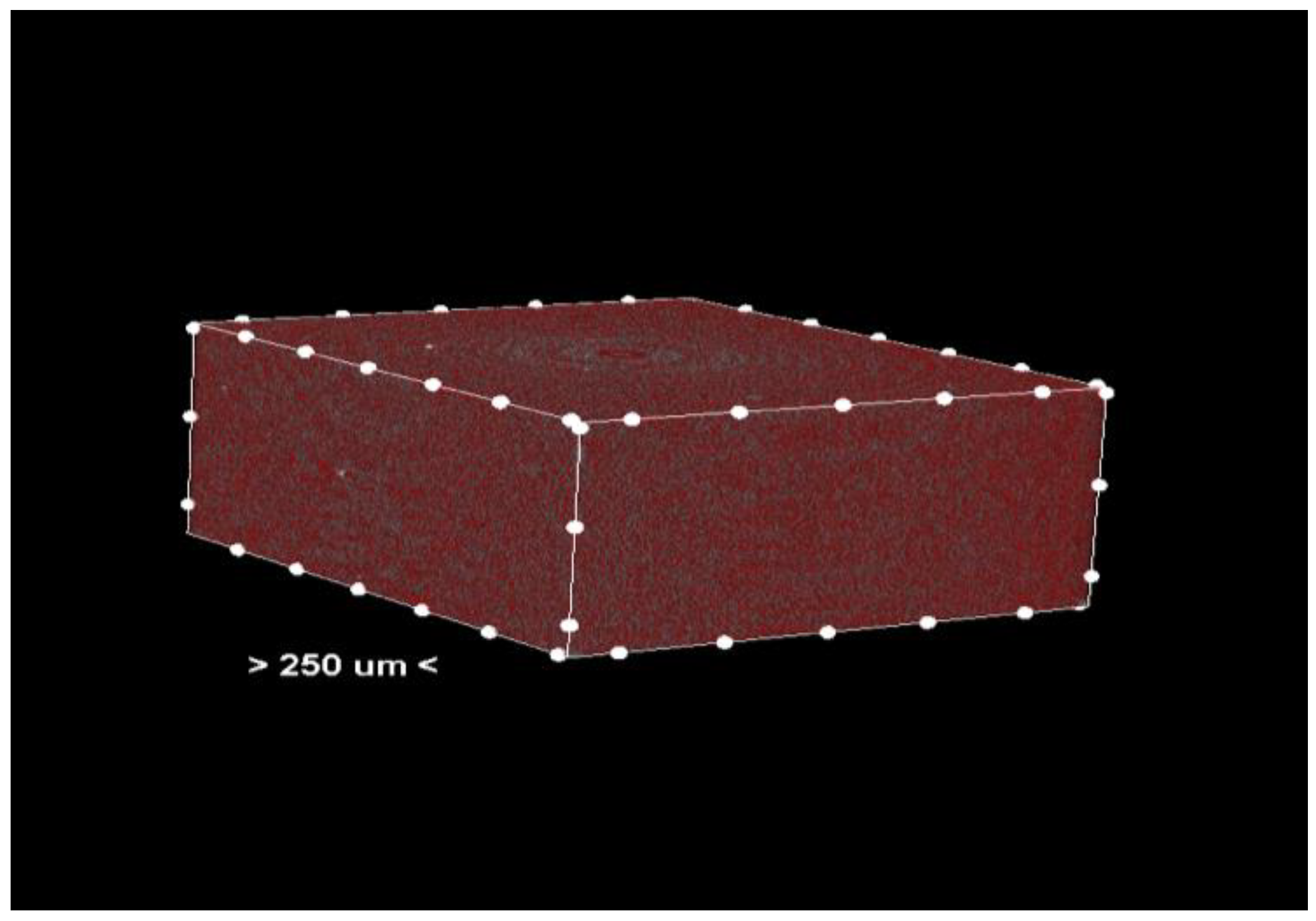

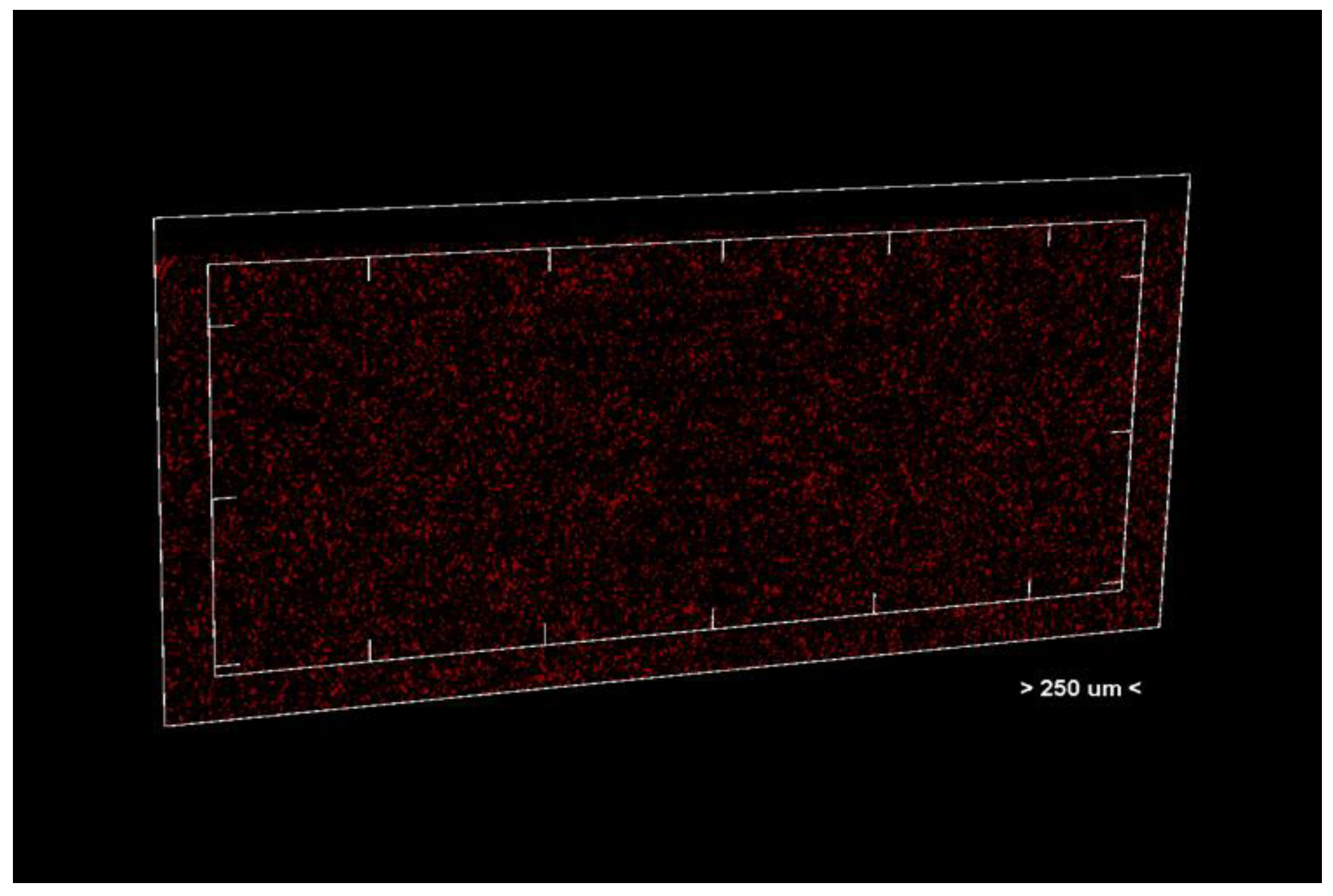
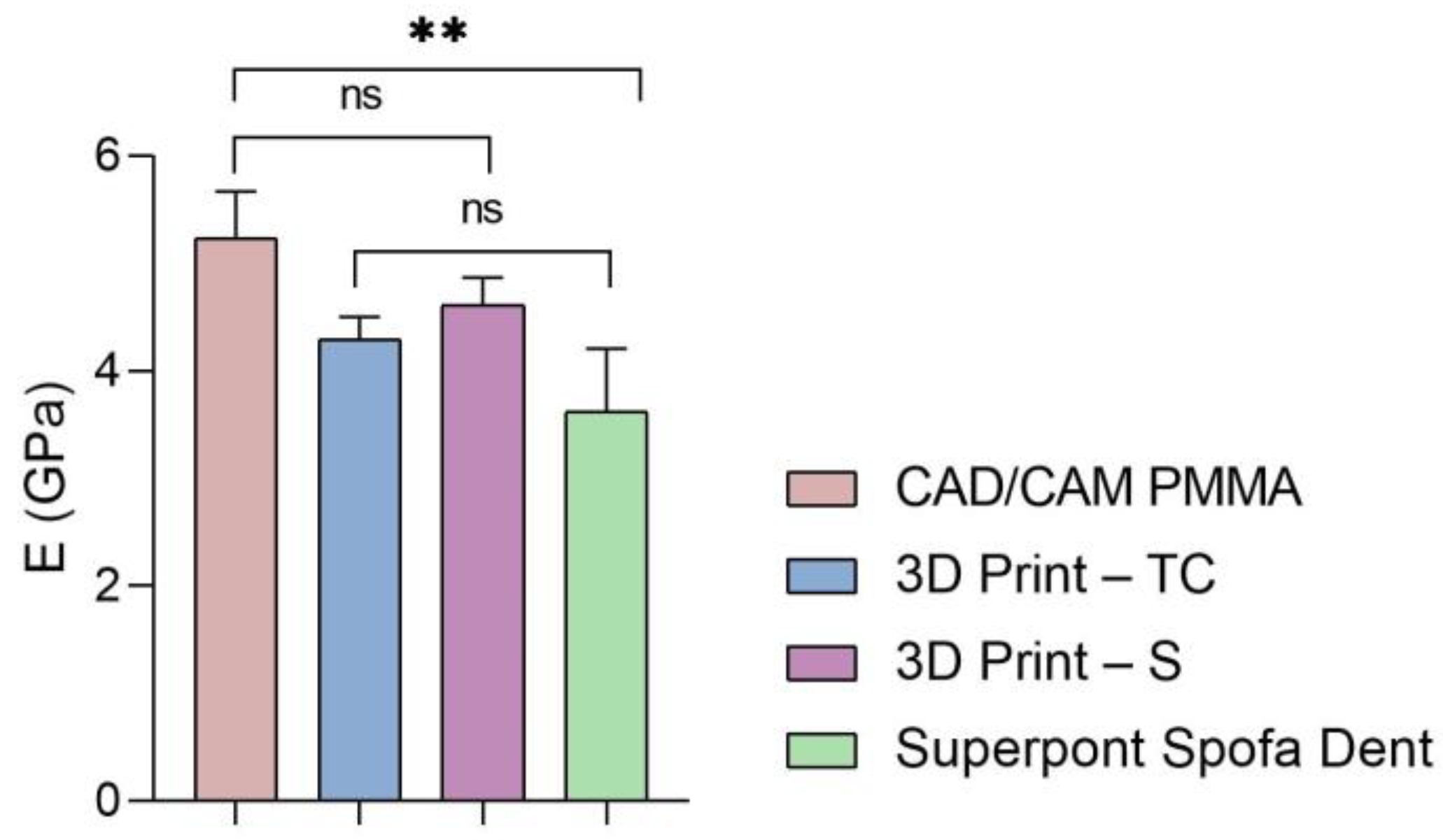
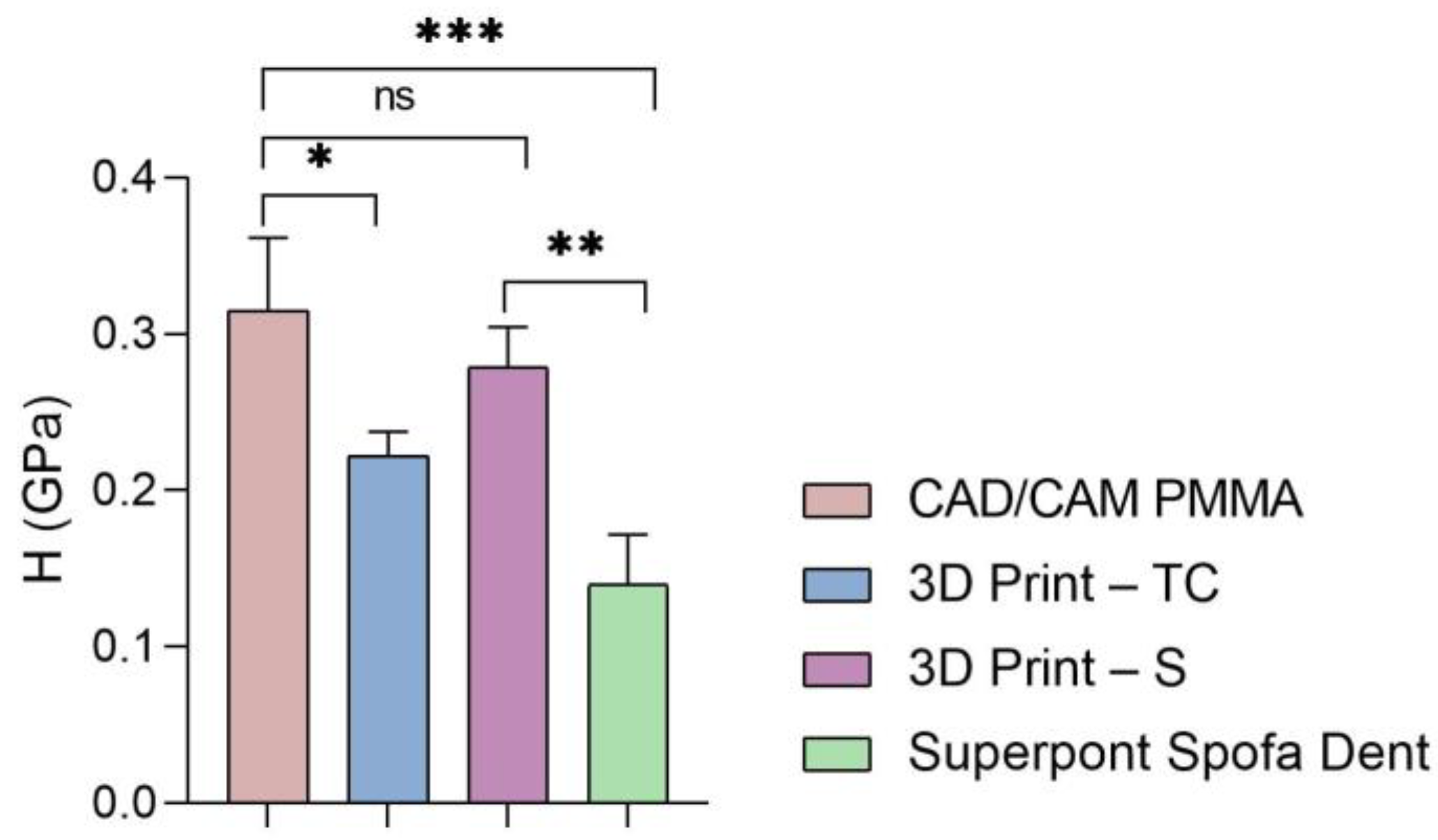



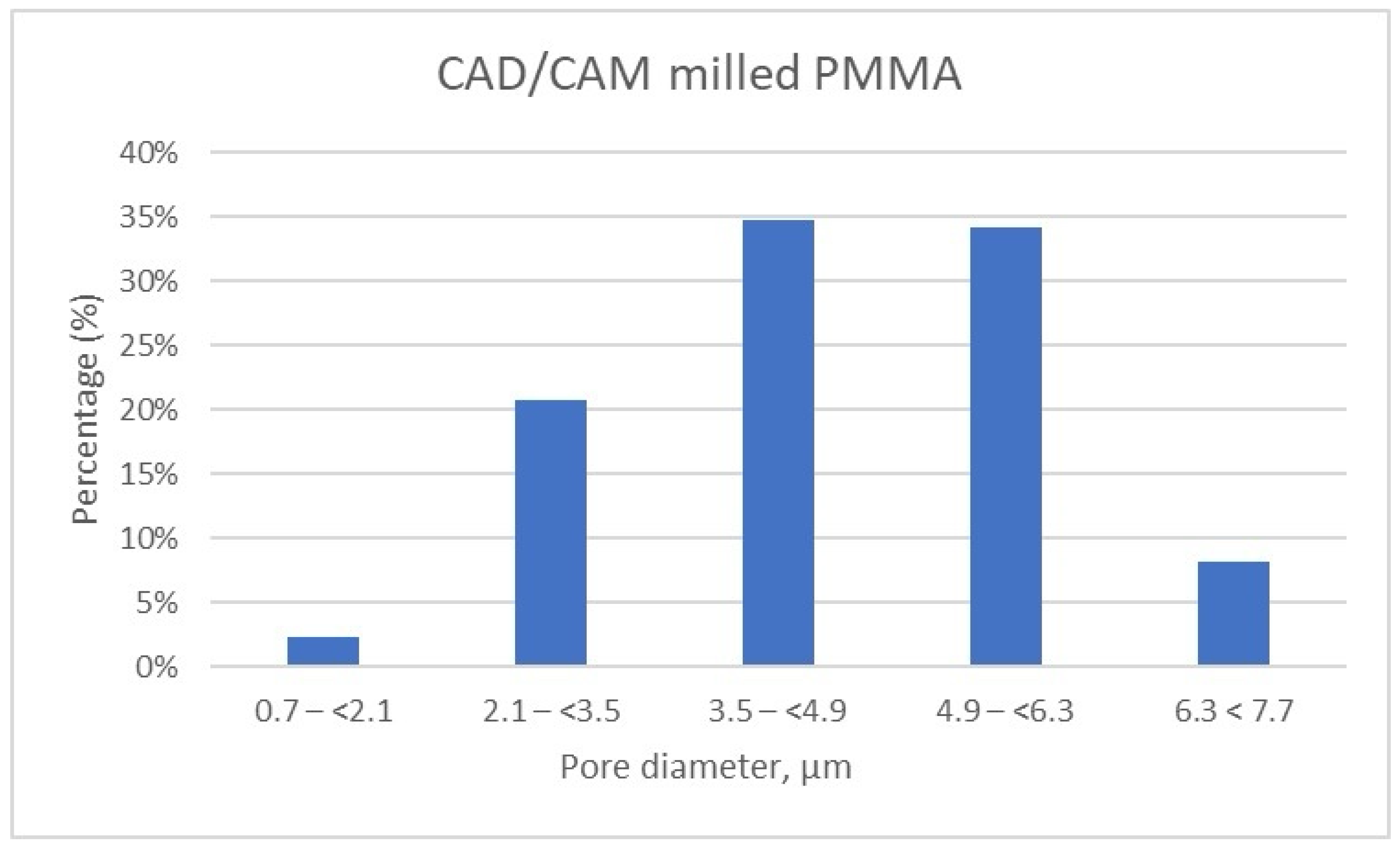

| Test | Surface Displacement | Sample Loading | Elasticity (Y Module) | Hardness | Stiffness |
|---|---|---|---|---|---|
| nm | Mn | GPa | GPa | N/m | |
| 1 | 533.5 | 1.7 | 5181 | 0.314 | 16,043 |
| 2 | 528.0 | 1.5 | 4828 | 0.270 | 14,946 |
| 3 | 559.8 | 2.1 | 5692 | 0.362 | 18,284 |
| Mean | 540.4 | 1.8 | 5233 | 0.315 | 16,424 |
| Std. Dev. | 17.0 | 0.3 | 0.434 | 0.046 | 1701 |
| Test | Surface Displacement | Sample Loading | Elasticity (Y-Module) | Hardness | Stiffness |
|---|---|---|---|---|---|
| nm | Mn | GPa | GPa | N/m | |
| 1 | 485.1 | 1.0 | 4125 | 0.205 | 11,910 |
| 2 | 502.6 | 1.2 | 4233 | 0.235 | 12,514 |
| 3 | 490.7 | 1.1 | 4524 | 0.226 | 13,188 |
| Mean | 492.8 | 1.1 | 4294 | 0.222 | 12,537 |
| Std. Dev. | 8.9 | 0.1 | 0.206 | 0.015 | 640 |
| Test | Surface Displacement | Sample Loading | Elasticity (Y-Module) | Hardness | Stiffness |
|---|---|---|---|---|---|
| nm | Mn | GPa | GPa | N/m | |
| 1 | 540.2 | 1.7 | 4908 | 0.308 | 15,327 |
| 2 | 526.2 | 1.4 | 4445 | 0.261 | 13,618 |
| 3 | 527.8 | 1.4 | 4486 | 0.268 | 13,714 |
| Mean | 531.4 | 1.5 | 4613 | 0.279 | 14,220 |
| Std. Dev. | 7.7 | 0.2 | 0.256 | 0.025 | 960 |
| Test | Surface Displacement | Sample Loading | Elasticity (Y-Module) | Hardness | Stiffness |
|---|---|---|---|---|---|
| nm | Mn | GPa | GPa | N/m | |
| 1 | 523.6 | 0.6 | 2984 | 0.111 | 9194 |
| 2 | 498.7 | 0.9 | 4121 | 0.174 | 12,200 |
| 3 | 512.1 | 0.8 | 3766 | 0.135 | 11,693 |
| Mean | 511.2 | 0.8 | 3552 | 0.142 | 10,697 |
| Std. Dev. | 17.6 | 0.2 | 0.804 | 0.044 | 2125 |
| 3D Print TC—Temporary Crowns | |||||
|---|---|---|---|---|---|
| Sections 150–1149 | Sections 1150–2149 | Sections 2150–3149 | Intercede | Std. Dev. | |
| Interval, μm | % in range | % in range | % in range | % in range | |
| 0.7–<2.1 | 14.39 | 15.31 | 16.55 | 15.41 | 0.89 |
| 2.1–<3.5 | 56.22 | 57.11 | 57.74 | 57.03 | 0.62 |
| 3.5–<4.9 | 26.21 | 24.84 | 23.24 | 24.76 | 1.22 |
| 4.9–<6.3 | 3.15 | 2.71 | 2.39 | 2.75 | 0.31 |
| 6.3 < | 0.03 | 0.03 | 0.09 | 0.05 | 0.03 |
| 3D Print S—Splint | |||||
|---|---|---|---|---|---|
| Sections 150–1149 | Sections 1150–2149 | Sections 2150–3149 | Intercede | Std. Dev. | |
| Pore diameter, μm | % in range | % in range | % in range | % in range | |
| 0.7–<2.1 | 34.31 | 32.28 | 32.98 | 33.19 | 0.84 |
| 2.1–<3.5 | 58.81 | 59.77 | 59.31 | 59.30 | 0.39 |
| 3.5–<4.9 | 6.77 | 7.80 | 7.59 | 7.39 | 0.44 |
| 4.9–<6.3 | 0.10 | 0.14 | 0.12 | 0.12 | 0.02 |
| 6.3 < 7.7 | 0.00 | 0.00 | 0.00 | ||
| CAD/CAM Milled PMMA | |||||
|---|---|---|---|---|---|
| Sections 150–1149 | Sections 1150–2149 | Sections 2150–3149 | Intercede | Std. Dev. | |
| Pore diameter, μm | % in range | % in range | % in range | % in range | |
| 0.7–<2.1 | 2.33 | 2.38 | 2.13 | 2.28 | 0.11 |
| 2.1–<3.5 | 21.04 | 21.41 | 19.60 | 20.68 | 0.78 |
| 3.5–<4.9 | 34.88 | 35.30 | 34.12 | 34.77 | 0.49 |
| 4.9–<6.3 | 33.87 | 33.42 | 35.11 | 34.13 | 0.71 |
| 6.3 < 7.7 | 7.88 | 7.49 | 9.04 | 8.14 | 0.66 |
| Sample | Section | Total Porosity, % | Open Porosity, % | Closed Porosity, % |
|---|---|---|---|---|
| 3D Print–TC | 150–1149 | 24.644 | 24.476 | 0.22195 |
| 1150–2149 | 23.403 | 23.198 | 0.26769 | |
| 2150–3149 | 20.75 | 20.403 | 0.4368 | |
| 3D Print–S | 150–1149 | 8.4264 | 1.7616 | 6.7842 |
| 1150–2149 | 9.5977 | 3.565 | 6.2557 | |
| 2150–3149 | 8.8072 | 2.1191 | 6.8329 | |
| milled PMMA | 150–1149 | 5.7364 | 5.7363 | 0.0038021 |
| 1150–2149 | 5.6784 | 5.6783 | 0.0041061 | |
| 2150–3149 | 5.7648 | 5.7647 | 0.0036571 |
| Sample | Average Total Porosity, % | Std. Dev. | Average Open Porosity, % | Std. Dev. | Average Closed Porosity, % | Std. Dev. |
|---|---|---|---|---|---|---|
| 3D Print–TC | 22.93 | 1.62 | 22.69 | 1.70 | 0.31 | 0.09 |
| 3D Print–S | 8.94 | 0.49 | 2.48 | 0.78 | 6.62 | 0.26 |
| milled PMMA | 5.727 | 0.36 | 5.72 | 0.36 | 0.00 | 0.00 |
Disclaimer/Publisher’s Note: The statements, opinions and data contained in all publications are solely those of the individual author(s) and contributor(s) and not of MDPI and/or the editor(s). MDPI and/or the editor(s) disclaim responsibility for any injury to people or property resulting from any ideas, methods, instructions or products referred to in the content. |
© 2025 by the authors. Licensee MDPI, Basel, Switzerland. This article is an open access article distributed under the terms and conditions of the Creative Commons Attribution (CC BY) license (https://creativecommons.org/licenses/by/4.0/).
Share and Cite
Imre, M.; Șaramet, V.; Ciocan, L.T.; Vasilescu, V.-G.; Biru, E.I.; Ghitman, J.; Pantea, M.; Ripszky, A.; Celebidache, A.L.; Iovu, H. Influence of the Processing Method on the Nano-Mechanical Properties and Porosity of Dental Acrylic Resins Fabricated by Heat-Curing, 3D Printing and Milling Techniques. Dent. J. 2025, 13, 311. https://doi.org/10.3390/dj13070311
Imre M, Șaramet V, Ciocan LT, Vasilescu V-G, Biru EI, Ghitman J, Pantea M, Ripszky A, Celebidache AL, Iovu H. Influence of the Processing Method on the Nano-Mechanical Properties and Porosity of Dental Acrylic Resins Fabricated by Heat-Curing, 3D Printing and Milling Techniques. Dentistry Journal. 2025; 13(7):311. https://doi.org/10.3390/dj13070311
Chicago/Turabian StyleImre, Marina, Veaceslav Șaramet, Lucian Toma Ciocan, Vlad-Gabriel Vasilescu, Elena Iuliana Biru, Jana Ghitman, Mihaela Pantea, Alexandra Ripszky, Adriana Lucia Celebidache, and Horia Iovu. 2025. "Influence of the Processing Method on the Nano-Mechanical Properties and Porosity of Dental Acrylic Resins Fabricated by Heat-Curing, 3D Printing and Milling Techniques" Dentistry Journal 13, no. 7: 311. https://doi.org/10.3390/dj13070311
APA StyleImre, M., Șaramet, V., Ciocan, L. T., Vasilescu, V.-G., Biru, E. I., Ghitman, J., Pantea, M., Ripszky, A., Celebidache, A. L., & Iovu, H. (2025). Influence of the Processing Method on the Nano-Mechanical Properties and Porosity of Dental Acrylic Resins Fabricated by Heat-Curing, 3D Printing and Milling Techniques. Dentistry Journal, 13(7), 311. https://doi.org/10.3390/dj13070311










